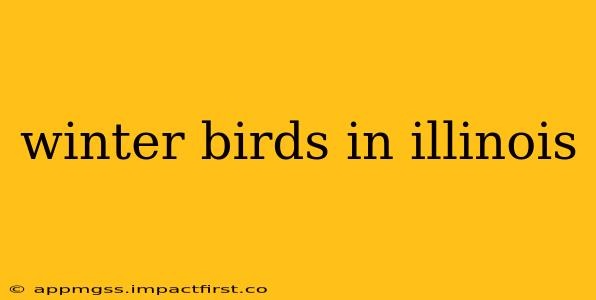Illinois experiences a dramatic shift in its avian population during winter. While some birds migrate south for warmer climates, a hardy group remains, braving the cold to enjoy a bounty of winter resources. This guide will explore the common winter birds you can spot in Illinois, their behaviors, and how to best observe them. We'll also answer some frequently asked questions about winter birding in the state.
What birds stay in Illinois during the winter?
Many bird species brave the Illinois winter. Some of the most common include:
- Northern Cardinal: A vibrant red male with a distinctive crest is a year-round resident, easily spotted in backyards and wooded areas.
- Downy Woodpecker: The smallest woodpecker in Illinois, these birds are frequent visitors to backyard feeders, readily consuming suet and seeds.
- Hairy Woodpecker: Slightly larger than its Downy cousin, the Hairy Woodpecker is also a common winter resident, often found foraging on tree trunks.
- Black-capped Chickadee: These tiny, energetic birds are highly adaptable and readily visit feeders, known for their cheerful "chick-a-dee-dee-dee" call.
- Tufted Titmouse: A gray bird with a prominent crest, the Tufted Titmouse is another feeder regular, often seen gleaning insects from branches.
- Blue Jay: A boisterous and intelligent bird, Blue Jays are striking with their blue, white, and black plumage. They are frequent visitors to feeders, especially during harsh weather.
- American Goldfinch: While many goldfinches migrate, some remain in Illinois throughout the winter, their yellow feathers a welcome splash of color against the snowy landscape. They primarily feed on seeds.
- Dark-eyed Junco: These slate-colored birds with a white belly are often seen foraging on the ground, hopping along under shrubs and trees.
- Northern Mockingbird: Known for their exceptional vocalizations, mimicking other birds and sounds, Northern Mockingbirds are year-round residents often found in brushy areas.
- Red-bellied Woodpecker: While their name suggests a fiery red belly, it's more of a rusty hue, but they are a colorful addition to the winter landscape.
Where can I find winter birds in Illinois?
Illinois offers diverse habitats suitable for winter birdwatching. Excellent locations include:
- State Parks and Nature Preserves: These protected areas often have diverse habitats and offer excellent opportunities for birdwatching, with trails and observation areas designed for viewing wildlife.
- Backyards and Suburban Areas: Surprisingly, your own backyard can be a great spot to observe winter birds, especially if you provide food and water sources.
- Forests and Woodlands: These areas offer shelter and food for many winter bird species. Look for areas with mature trees and diverse understory vegetation.
- Wetlands and Waterways: Areas near water sources attract many birds, especially those that feed on aquatic insects or seeds.
What do winter birds eat in Illinois?
The diet of winter birds in Illinois varies greatly depending on the species. Many rely on:
- Seeds: Sunflower seeds, millet, and other seeds are highly popular among many species at backyard feeders.
- Suet: A high-energy food source made from rendered beef fat, suet is a valuable winter food for woodpeckers and other birds.
- Nuts: Peanuts, acorns, and other nuts are also attractive to many species.
- Berries: Persistent berries on shrubs and trees provide a valuable food source for some birds.
- Insects: While insect populations decline in winter, some birds are skilled at finding and consuming those that remain.
What are some tips for birdwatching in Illinois during winter?
- Dress warmly: Winter birdwatching can be chilly, so dress in layers to stay warm and comfortable.
- Use binoculars: Binoculars are essential for getting a closer look at birds.
- Bring a field guide: A field guide will help you identify the birds you see.
- Be patient: Birds can be shy and elusive, so be patient and take your time observing them.
- Respect wildlife: Maintain a safe distance from birds and avoid disturbing their habitat.
- Consider visiting during peak migration times: While this guide focuses on winter residents, understanding peak migration periods within the state can yield exciting birdwatching experiences, too.
How can I attract birds to my backyard in winter?
Providing food, water, and shelter can significantly increase your chances of seeing birds in your backyard during winter. Consider:
- Bird feeders: Offer a variety of seeds, suet, and nuts to attract different species.
- Bird baths: Provide a source of fresh water, even if it needs to be thawed occasionally.
- Shelter: Plant shrubs and trees to provide cover and protection from the elements.
By understanding the habits and needs of Illinois' winter bird population, you can significantly enhance your birdwatching experience. So grab your binoculars, dress warmly, and prepare to be amazed by the resilient avian life that calls Illinois home even in the coldest months.
